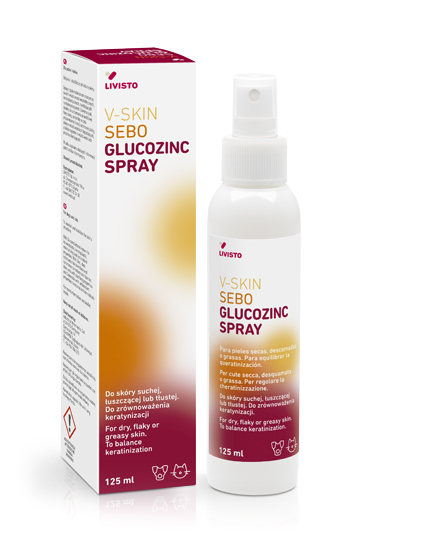Spray przeciw łuszczeniu
skóry dla psa i kota
Spray przeciw łuszczeniu skóry dla psa i kota
V-SKIN
SEBO
GLUCOZINC SPRAY
Aby poradzić sobie z zaburzeniami łojotokowymi u psów i kotów, należy nawilżyć i złuszczyć skórę, odbudować barierę skórną i kontrolować zakażenie Malassezia.
Spray GlucoZinc odbudowuje i naprawia barierę skórną, która odpowiada za homeostazę ekosystemu skóry. Jego stosowanie pomaga zapobiegać nawrotom choroby.
Stanowi również dobre uzupełnienie leczenia i profilaktyki zapalenia skóry wywołanego przez Malassezia.

Najważniejsze kwestie:
- Zawiera glukonolakton – składnik o działaniu keratolitycznym wpływającym na łuszczenie się skóry.1, 2, 3, 4, 5
- Nagietek i aloes mają właściwości przeciwzapalne, kojące i łagodzące.7, 8, 9, 10, 11, 12, 13, 14, 15, 16, 17
- Cynk działa przeciwbakteryjnie i przeciwgrzybiczo.6
- Ceramidy odbudowują nabłonek, utrzymują funkcję barierową i nawilżają skórę.18, 19, 20
Kiedy stosować:
- Spray bez spłukiwania może być również stosowany w miejscach trudno dostępnych, takich jak przestrzeń między palcami, w celu przywrócenia równowagi skóry i jej delikatnego złuszczania.
Sposób użycia:
- Spryskać żądany obszar.
- Nie wymaga spłukiwania.
- Można stosować codziennie. W niektórych przypadkach może być zalecane przycięcie sierści w celu ułatwienia kontaktu produktu ze skórą.
Obejrzyj materiał wideo dotyczący stosowania produktu!
Opinie lekarzy weterynarii
I used SEBOGLUCOZINC SPRAY for a female dog with extreme flaky, greasy skin. After several actions, including spray use and dietary changes, the condition improved quickly.

Absorbs quickly, while the skin's moisturising effect is visible - clearly rebuilds the skin's hydrolipidic layer.

Bibliografia
- Berardesca E, Distante F, Vignoli GP, Oresajo C, Green B. Alpha hydroxyacids modulate stratum corneum barrier function. Br J Dermatol 1997;137:934-938.
- Hachem JP, Roelandt T, Schürer N, Pu X, Fluhr J, Giddelo C, Man M-Q, Crumrine D, Roseeuw D, Feingold KR, Mauro T, Elias PM. Acute acidification of stratum corneum membrane domains using polyhydroxyl acids improves lipid processing and inhibits degradation of corneodesmosomes. J Invest Dermatol. 2010;130:500-10.
- Bernstein EF, Brown DB, Schwartz MD, Kaidbey K, Ksenzenko SM. The polyhydroxy acid gluconolactone protects against ultraviolet radiation in an in vitro model of cutaneous photoaging. Dermatol Surg. 2004;30:189-196.
- Puigdemont A, Furiani N, De Lucia M, Carrasco I, Ordeix L, Fondevila D, Ramió-Lluch L, Brazis P. Topical polyhydroxy acid treatment for autosomal recessive congenital ichthyosis in the golden retriever: a prospective pilot study. Vet Dermatol. 2018; 29: 323-e113. May 22. doi: 10.1111/vde.12654
- Jarząbek-Perz, S., Mucha, P.; Rotsztejn, H. (2021). Corneometric evaluation of skin moisture after application of 10% and 30% gluconolactone. Skin Research and Technology, (5), 925–930.
https://doi.org/10.1111/srt.13044 - Abendrot, M., & Kalinowska-Lis, U. (2018). Zinc-containing compounds for personal care applications. In International Journal of Cosmetic Science (Vol. 40, Issue 4, pp. 319–327). Blackwell Publishing Ltd.
https://doi.org/10.1111/ics.12463 - Hekmatpou, D., Mehrabi, F., Rahzani, K., & Aminiyan, A. (2019). The effect of aloe vera clinical trials on prevention and healing of skin wound: A systematic review. In Iranian Journal of Medical Sciences (Vol. 44, Issue 1).
- Sánchez, M., González-Burgos, E., Iglesias, I., & Gómez-Serranillos, M. P. (2020). Pharmacological update properties of aloe vera and its major active constituents. In Molecules (Vol. 25, Issue 6).
https://doi.org/10.3390/molecules25061324 - Teplicki, E., Ma, Q., Castillo, D. E., Zarei, M., Hustad, A. P., Chen, J., & Li, J. (2018). The effects of aloe vera on wound healing in cell proliferation, migration, and viability. Wounds, 30(9).
- Kamr, A., Arbaga, A., El-Bahrawy, A., Elsify, A., Khaled, H., & Hassan, H. (2020). The therapeutic efficacy of Aloe vera gel ointment on staphylococcal pyoderma in dogs. Veterinary World, 13(11).
https://doi.org/10.14202/VETWORLD.2020.2371-2380 - Arbaga, A., El-Bahrawy, A., Elsify, A., Khaled, H., Hassan, H. Y., & Kamr, A. (2021). Biochemical and histopathological changes related to the topical application of Aloe vera ointment for canine pyoderma. Veterinary World, 14(5).
https://doi.org/10.14202/vetworld.2021.1354-1362 - Preethia, K. C., Kuttanb, G; Kuttan, R. (2009). Anti-inflammatory activity of flower extract of Calendula officinalis Linn. and its possible mechanism of action. Indian Journal of Experimental Biology 2009 47(2)
- Tresch, M., Mevissen, M., Ayrle, H., Melzig, M., Roosje, P.; Walkenhorst, M. (2019). Medicinal plants as therapeutic options for topical treatment in canine dermatology? A systematic review. BMC Veterinary Researc, (1).
https://doi.org/10.1186/s12917-019-1854-4 - Giostri, G. S., Novak, E. M.; Guarita-Souza, L. C. (2021). Treatment of acute wounds in hand with Calendula officinalis L.: A randomized trial. Tissue Barriers.
https://doi.org/10.1080/21688370.2021.1994822 - Cruceriu, D., Balacescu, O; Rakosy, E. (2018). Calendula officinalis: Potential Roles in Cancer Treatment and Palliative Care. In Integrative Cancer Therapies (Vol. 16, Issue 4, pp. 1068–1078). SAGE Publications Inc.
https://doi.org/10.1177/1534735418803766 - Lima, M. dos R., Lopes, A. P., Martins, C., Brito, G. A. C., Carneiro, V. C; Goes, P. (2017). The effect of Calendula officinalis on oxidative stress and bone loss in experimental periodontitis. Frontiers in Physiology, (JUN).
https://doi.org/10.3389/fphys.2017.00440 - John, R.; Jan, N. (2017). Calendula Officinalis-An Important Medicinal Plant with Potential Biological Properties.Proceedings of the Indian National Science Academy,(0).
https://doi.org/10.16943/ptinsa/2017/49126 - ung, J. Y., Nam, E. H., Park, S. H., Han, S. H.; Hwang, C. Y. (2013). Clinical use of a ceramide-based moisturizer for treating dogs with atopic dermatitis. Journal of Veterinary Science, 14(2), 199–205.
https://doi.org/10.4142/jvs.2013.14.2.199 - Reiter, L. v., Torres, S. M. F.; Wertz, P. W. (2009). Characterization and quantification of ceramides in the nonlesional skin of canine patients with atopic dermatitis compared with controls. Veterinary Dermatology, 20(4), 260–266.
https://doi.org/10.1111/j.1365-3164.2009.00759.x. - Yoon, J. S., Nishifuji, K., Ishioroshi, S., Ide, K.; Iwasaki, T. (2013). Skin lipid profiling in normal and seborrhoeic shih tzu dogs. Veterinary Dermatology, 24(1).
https://doi.org/10.1111/j.1365-3164.2012.01102.x.


 Używamy plików cookie na naszej stronie internetowej, aby zapewnić Ci najbardziej odpowiednie wrażenia poprzez zapamiętywanie Twoich preferencji i powtarzanie wizyt. Klikając „Akceptuj”, użytkownik wyraża zgodę na używanie WSZYSTKICH plików cookie. Możesz jednak odwiedzić Ustawienia plików cookie, aby wyrazić kontrolowaną zgodę.
Używamy plików cookie na naszej stronie internetowej, aby zapewnić Ci najbardziej odpowiednie wrażenia poprzez zapamiętywanie Twoich preferencji i powtarzanie wizyt. Klikając „Akceptuj”, użytkownik wyraża zgodę na używanie WSZYSTKICH plików cookie. Możesz jednak odwiedzić Ustawienia plików cookie, aby wyrazić kontrolowaną zgodę.